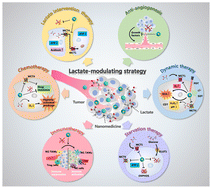Engineering lactate-modulating nanomedicines for cancer therapy
Abstract
Lactate in tumors has long been considered “metabolic junk” derived from the glycolysis of cancer cells and utilized only as a biomarker of malignancy, but is presently believed to be a pivotal regulator of tumor development, maintenance and metastasis. Indeed, tumor lactate can be a “fuel” for energy supply and functions as a signaling molecule, which actively contributes to tumor progression, angiogenesis, immunosuppression, therapeutic resistance, etc., thus providing promising opportunities for cancer treatment. However, the current approaches for regulating lactate homeostasis with available agents are still challenging, which is mainly due to the short half-life, low bioavailability and poor specificity of these agents and their unsatisfactory therapeutic outcomes. In recent years, lactate modulation nanomedicines have emerged as a charming and efficient strategy for fighting cancer, which play important roles in optimizing the delivery of lactate-modulating agents for more precise and effective modulation and treatment. Integrating specific lactate-modulating functions in diverse therapeutic nanomedicines may overcome the intrinsic restrictions of different therapeutic modalities by remodeling the pathological microenvironment for achieving enhanced cancer therapy. In this review, the most recent advances in the engineering of functional nanomedicines that can modulate tumor lactate for cancer therapy are summarized and discussed, and the fundamental mechanisms by which lactate modulation benefits various therapeutics are elucidated. Finally, the challenges and perspectives of this emerging strategy in the anti-tumor field are highlighted.



 Please wait while we load your content...
Please wait while we load your content...